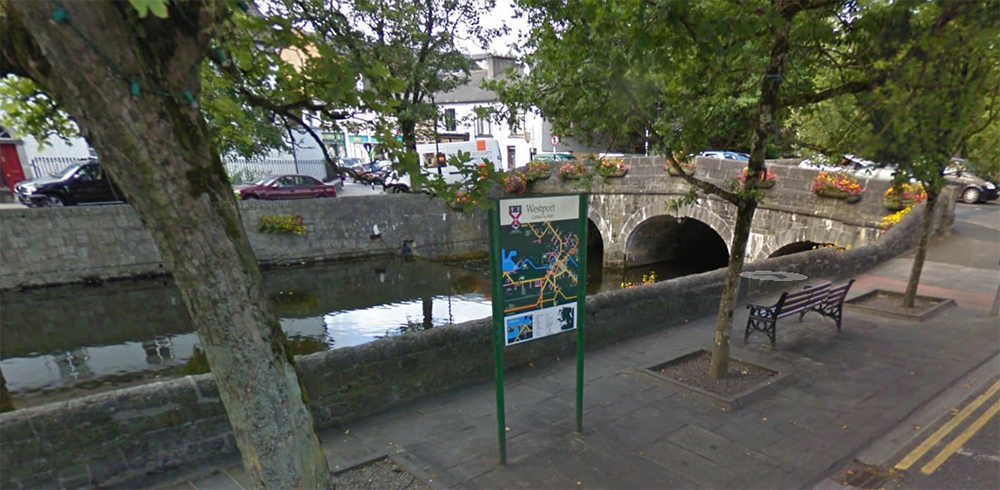The following is a proposal by Westport Historical Society to name the bridge adjoining James Street and Newport Road;
Westport Historical Society is proposing that the bridge linking James Street and Newport Street in Westport be named “The Doris Brothers Bridge”, in honour of William and Patrick J. Doris. Together and individually, the Doris brothers made significant contributions to the social and political development of Mayo in the late 19th and early 20th centuries. Those contributions may be summarized as follows:
William Doris was born in Westport in 1860 and spent his early career as a journalist. In 1879, he became the first secretary of the Land League, an organization which had a profound effect on the course of Irish history, and helped organize the historic Westport meeting, at which Parnell and Davitt addressed their followers together for the first time. In 1881, he helped draft the famous “No-Rent Manifesto” – one of the major documents in Irish history. For his Land League activities, he spent six months in jail. In 1892, with his brother P.J., he co-founded the Mayo News and in 1898 he became a founding Hon. Secretary of the United Irish League, a nationally-important organization which was established in Westport and campaigned for the abolition of landlordism.
William was a member of the first Mayo County Council and of the first Westport Urban District Council, serving as chairman of both bodies on numerous occasions. In 1910, he was elected Irish Parliamentary Party M.P. for West Mayo, taking an active part in the historic Home Rule debates. An M.P. until 1918, he continued working on behalf of the Irish people until his death in 1926.
Patrick Joseph Doris was born in Westport in 1866. He too was an early member of the Land League, also a member of the Fenian Brotherhood. As an official of the Westport Poor Law Union, he did important work towards the enfranchisement of poorer ratepayers. As Hon. Secretary of the Congested Districts Board’s committee in Westport, he helped improve the lives of labourers and farmers in West Mayo. Through the Mayo News he fought the injustices of the landlord system and British rule in Ireland. In the 1910s, his was a crucial role in the campaign to have the town of Westport purchased from Lord Sligo. In the wake of the Easter Rising 1916, because of his prominent local role in the Irish Volunteers and Sinn Féin, he was arrested and interned in Britain for almost eight months. He and his newspaper were subject to numerous harassments and restrictions during the War of Independence.
Through the Mayo News, and his political activity, he continued to campaign for the betterment of the people of Mayo and Ireland up to his death in 1937.
Here are some benefits of the proposal:
When Irish Nationalism split in the 1910s, Patrick followed the Irish Volunteers / Sinn Féin side and William followed the Irish Party / Redmondite side. In this sense, they are representative of both sides of the nationalist movement. Therefore, in commemorating them both we are not endorsing either side. In that sense, the proposal to name the bridge in their honour is not a controversial one.
Besides their political contributions, the brothers deserve public recognition for establishing the Mayo News, which has been such an important element of Mayo life over the past 124 years. Not alone that, but the newspaper was founded on James Street, which ties-in perfectly with the proposal to name the James Street bridge in their honour.
Although informally known as “the James Street bridge”, it has never had an official designation. Therefore, the current proposal is not to rename the bridge, but rather to name it. Naming the bridge in the Doris brothers’ honour, and erecting an appropriate plaque, would inform locals and visitors alike about important episodes in Westport’s history. Although many have paid tribute to the Doris brothers in print and word over the years, this is the first proposal to honour them with a permanent, public memorial. To erect a plaque and to officially designate the James Street bridge as “The Doris Brothers bridge” would be a lasting legacy of this generation of Westport people. And to do so at the centenary of 1916 would be particularly fitting.
Westport Historical Society is not seeking financial contributions towards this project. We simply wish to inform the public of the idea and provide them with an opportunity of making observations or asking questions about it. If the proposal meets with public approval, the intention is to unveil the plaque on 8 May next, on which day Westport Historical Society will also be unveiling a plaque (on the MacBride monument on the South Mall) in commemoration of the 31 men arrested in Westport in 1916.
If you have any observations regarding this project, please contact Westport Historical Society at the
Clew Bay Heritage Centre: 098-26852 / email: westportheritage@eircom.net.


 www.westportheritage.com
www.westportheritage.com